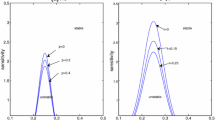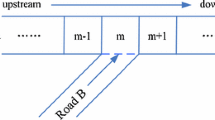Abstract
Based on the anticipation lattice hydrodynamic models, which are described by the partial differential equations, the continuum version of the model is investigated through a reductive perturbation method. The linear stability theory is used to discuss the stability of the continuum model. The Korteweg–de Vries (for short, KdV) equation near the neutral stability line and the modified Korteweg–de Vries (for short, mKdV) equation near the critical point are obtained by using the nonlinear analysis method. And the corresponding solutions for the traffic density waves are derived, respectively. The results display that the anticipation factor has an important influence on traffic flow. From the simulation, it is shown that the traffic jam is suppressed efficiently with taking into account the anticipation effect, and the analytical result is consonant with the simulation one.


Similar content being viewed by others
References
Treiber, M., Kesting, A.: Traffic Flow Dynamics. Springer, Berlin (2013)
Treiber, M., Kesting, A.: Evidence of convective instability in congested traffic flow: a systematic empirical and theoretical investigation. Transp. Res., Part B, Methodol. 45, 1362–1377 (2011)
Tang, T.Q., Li, C.Y., Huang, H.J., Shang, H.Y.: A new fundamental diagram theory with the individual difference of the driver’s perception ability. Nonlinear Dyn. 67, 2255–2265 (2012)
Tang, T.Q., Huang, H.J., Xu, G.: A new macro model with consideration of the traffic interruption probability. Physica A 387, 6845–6856 (2008)
Tang, T.Q., Li, C.Y., Wu, Y., Huang, H.J.: Impact of the honk effect on the stability of traffic flow. Physica A 390, 3362–3368 (2011)
Tian, H.H., Xue, Y.: A lattice hydrodynamical model considering turning capability. Chin. Phys. B 21, 070505 (2012)
Tang, T.Q., Huang, H.J., Shang, H.Y.: A new macro model for traffic flow with the consideration of the driver’s forecast effect. Phys. Lett. A 374, 1668–1672 (2010)
Peng, G.H., Cai, X.H., Cao, B.F., Liu, C.Q.: A new lattice model of traffic flow with the consideration of the traffic interruption probability. Physica A 391, 656–663 (2012)
Peng, G.H.: A driver’s memory lattice model of traffic flow and its numerical simulation. Nonlinear Dyn. 67, 1811–1815 (2012)
Ngoduy, D.: Instabilities of cooperative adaptive cruise control traffic flow: a macroscopic approach. Commun. Nonlinear Sci. Numer. Simul. 18, 2838–2851 (2013)
Lighthill, M.J., Whitham, G.B.: On kinematic waves. II. A theory of traffic flow on long crowded roads. Proc. R. Soc. Lond. Ser. A, Math. Phys. Sci. 229, 281 (1955)
Lighthill, M.J., Whitham, G.B.: On kinematic waves. II. Theory of traffic flow on long crowded roads. Proc. R. Soc. Lond. Ser. A, Math. Phys. Sci. 229, 317–345 (1955)
Richards, P.I.: Shock waves on the high way. Oper. Res. 4, 4251 (1956)
Payne, H.J.: Models of freeway traffic and control. In: Bekey, G.A. (ed.) Mathematical Models of Public Systems. Proc. 1971 SCI Conference. Simulation Councils Proceedings Series, vol. 1, La Jolla, CA, pp. 51–56 (1971)
Treiber, M., Kesting, A., Helbing, D.: Delays, inaccuracies and anticipation in microscopic traffic model. Physica A 360, 71–88 (2006)
Ngoduy, D., Wilson, R.E.: Multi-anticipative nonlocal second order traffic model. Comput.-Aided Civil Infrastruct. Eng. 7 (2013)
Nagatani, T.: Modified KdV equation for jamming transition in the continuum models of traffic. Physica A 261, 599–607 (1998)
Ge, H.X., Dai, S.Q., Xue, Y., Dong, L.Y.: Phase transition and modified KdV equation in a cooperation system. Phys. Rev. E 71, 066119 (2005)
Ge, H.X.: Traffic anticipation effect in the lattice hydrodynamic model. In: Appert-Rolland, C., Chevoir, F., Gondret, P., lassarre, S., Lebacque, J.-P., Schreckenberg, M. (eds.) Traffic and Granular Flow’07, Orsay, France, pp. 293–299 (2007)
Nagatani, T.: Jamming transition in a two-dimensional. Phys. Rev. E 59, 4857–4864 (1999)
Nagatani, T.: Thermodynamic theory for jamming transition in traffic flow. Phys. Rev. E 58, 4271–4276 (1998)
Ge, H.X., Cheng, R.J., Dai, S.Q.: KdV and kink–antikink solitons in car-following models. Physica A 357(3–4), 466 (2005)
Acknowledgement
Project supported by the National Natural Science Foundation of China (Grant Nos. 11072117, 11372166 and 61074142), the Scientific Research Fund of Zhejiang Provincial, China (Grant No. LY13A010005), Disciplinary Project of Ningbo, China (Grant No. SZXL1067) and the K.C. Wong Magna Fund in Ningbo University, China.
Author information
Authors and Affiliations
Corresponding author
Appendix
Appendix
Substituting Eqs. (12)–(13) into Eq. (10), then we get the linearized equation,
where V′(ρ 0)=dV(ρ)/dρ, at ρ=ρ 0. Expanding y(x,t)=exp(ikx+zt), we have
Prescribing z=z 1(ik)+z 2(ik)2+⋯ and \(\exp(ik)=1+ik+\frac{1}{2}(ik)^{2}+\cdots\), inserting them into Eq. (38), and keeping the first- and second-order terms of ik, then we get the coefficients of z, respectively,
If z 2 is a positive value, the uniform flow is stable. If z 2 is a negative value, the uniform flow is unstable for long wavelength modes. So we get the unstable condition
Rights and permissions
About this article
Cite this article
Cheng, RJ., Li, ZP., Zheng, PJ. et al. The theoretical analysis of the anticipation lattice models for traffic flow. Nonlinear Dyn 76, 725–731 (2014). https://doi.org/10.1007/s11071-013-1164-5
Received:
Accepted:
Published:
Issue Date:
DOI: https://doi.org/10.1007/s11071-013-1164-5




